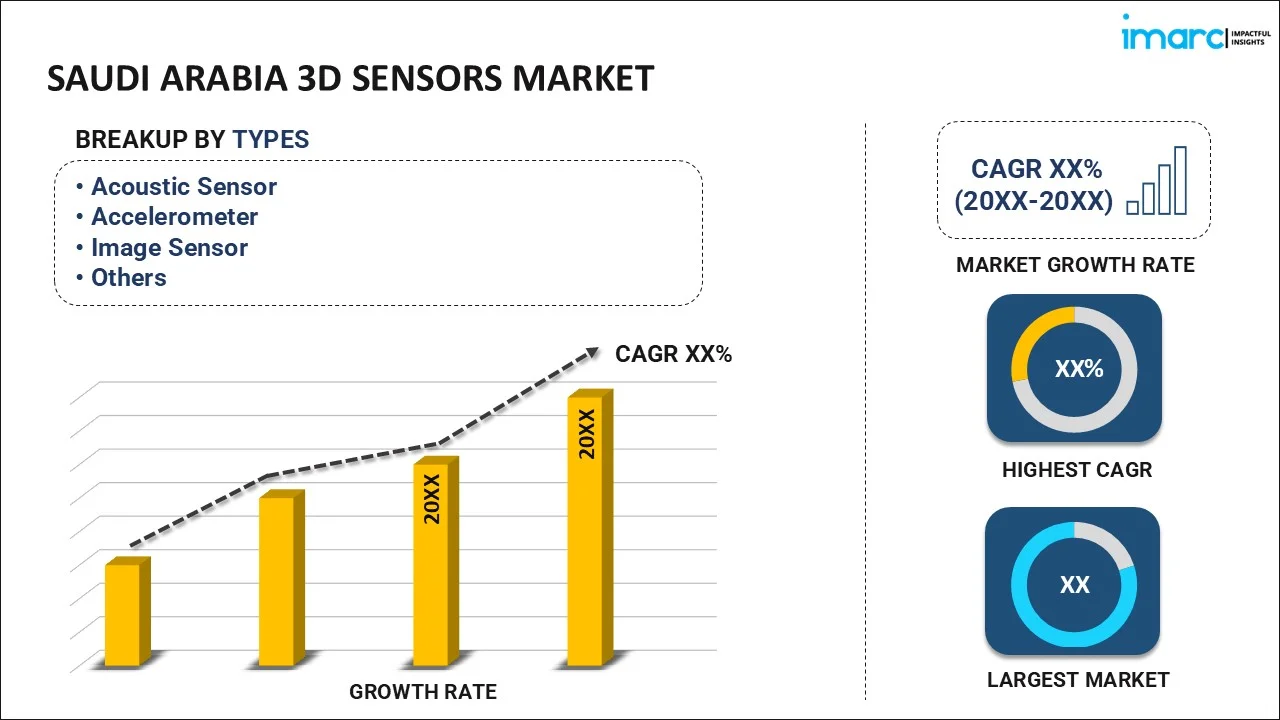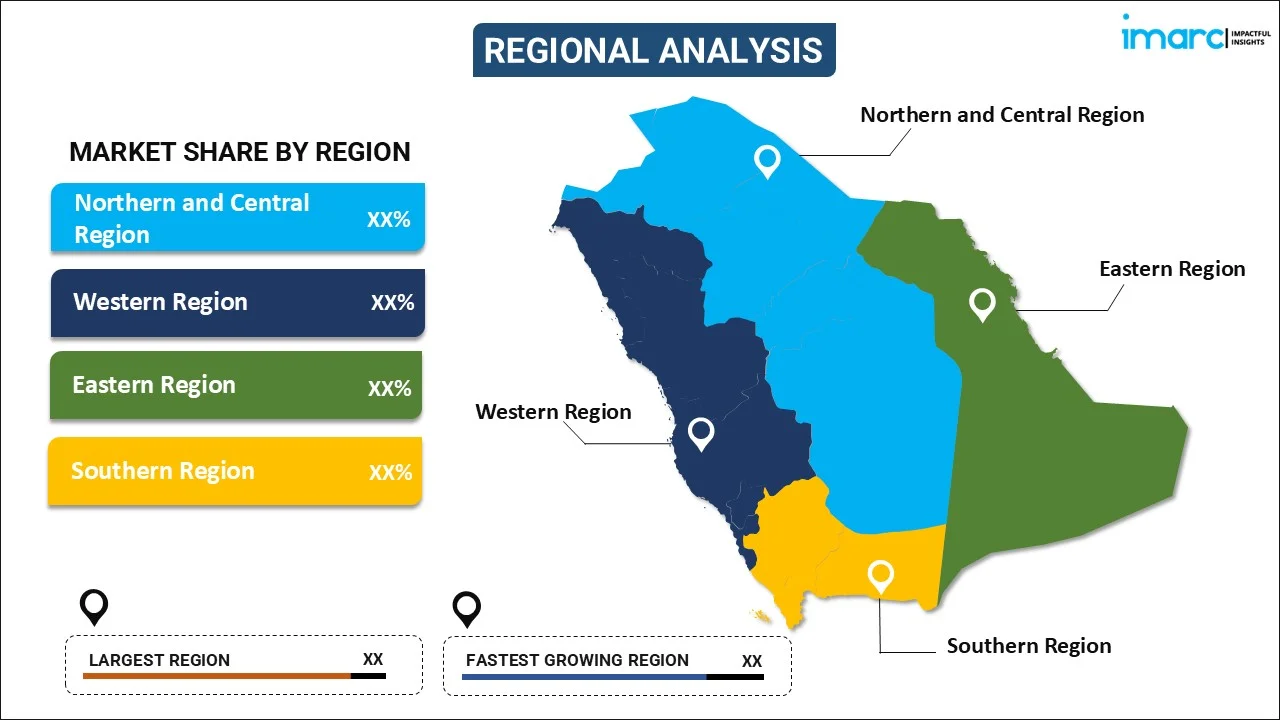
Saudi Arabia 3D Sensors Market Size, Share, Trends and Forecast by Type, Technology, End-User, and Region, 2025-2033
Saudi Arabia 3D Sensors Market Size and Share:
The Saudi Arabia 3D sensors market size reached USD 70.15 Million in 2024. Looking forward, IMARC Group expects the market to reach USD 378.58 Million by 2033, exhibiting a growth rate (CAGR) of 19.20% during 2025-2033. The market is experiencing robust growth due to technological advancements, expanding applications in consumer electronics, and rising demand across industrial and automotive sectors for enhanced safety and automation capabilities.
|
Report Attribute
|
Key Statistics
|
|---|---|
|
Base Year
|
2024
|
|
Forecast Years
|
2025-2033
|
|
Historical Years
|
2019-2024
|
| Market Size in 2024 | USD 70.15 Million |
| Market Forecast in 2033 | USD 378.58 Million |
| Market Growth Rate (2025-2033) | 19.20% |
Saudi Arabia 3D Sensors Market Trends:
Advancements in Consumer Electronics and Smart Devices
The rising adoption of advanced consumer electronics is a major trend boosting the Saudi Arabia 3D sensors market share. In addition, technology has become more integrated into daily life, and the demand for smartphones, tablets, gaming consoles, and smart home devices equipped with 3D sensing capabilities is growing. Features like facial recognition, gesture control, and augmented reality (AR) applications are elevating the user experience and interaction that are enabled by these sensors. Brands are focusing on embedding 3D sensors to meet consumer expectations for more interactive and secure devices. The adaptation of these sensors into smart televisions and home automation systems is further boosting their usage amongst the audience. This shift towards high-tech consumer products is bolstering continuous research and innovation within the market, encouraging manufacturers to develop sensors with higher precision and reliability. Additionally, Saudi Arabia's commitment to advancing 3D sensing technologies extends beyond consumer electronics into defense applications. For instance, during the World Defence Show in Riyadh in February 2024, companies like MetaSensing engaged in strategic partnerships and discussions, emphasizing the country’s focus on integrating 3D sensing into advanced defense systems. The growing disposable income among the population and tech-savvy younger people in Saudi Arabia are contributing to this trend which is making the country an important market for electronics incorporating 3D sensor technology.
Growing Applications in the Automotive Sector
The automotive industry in Saudi Arabia is intensely utilizing 3D sensors to enhance vehicle safety and functionality, especially within autonomous driving and advanced driver assistance systems (ADAS). These sensors are becoming an important component for enabling real-time data processing and environmental scanning. These sensors play a vital role in lane departure warning systems, adaptive cruise control, parking assistance, and collision avoidance mechanisms. The need for enhanced safety features and semi-autonomous vehicles is prompting automakers to fuse 3D sensors that offer precise depth perception and object detection. The development of electric and hybrid vehicles is also incorporating 3D sensing technology to improve battery management and in-cabin experiences, such as gesture control for infotainment systems. The country’s strategic initiatives to diversify its economy and reduce dependency on oil as outlined in Vision 2030, are motivating investments in the automotive and technological sectors. For example, in 2024, Crown Prince Mohammed bin Salman inaugurated the King Salman Automotive Cluster within King Abdullah Economic City (KAEC), a dedicated hub designed to centralize automotive manufacturing by housing both local and international companies. This initiative aligns with the country’s broader Vision 2030 strategy to diversify its economy and reduce dependency on oil, fostering a thriving ecosystem for automotive innovation. These initiatives are enhancing the Saudi Arabia 3D sensor market outlook, by integrating improved technology in vehicles which is advancing innovation and higher safety standards in the region's automotive market.
Expanding Industrial Automation and Robotics
The surge in industrial automation is another significant trend driving the Saudi Arabia 3D sensors market growth. The industry in the region is progressively adopting smart manufacturing and automated solutions as the need for sensors capable of precise spatial recognition and real-time data capture is becoming essential. 3D sensors are utilized in robotic systems for tasks, such as object manipulation, sorting, and assembly line inspection, enabling higher efficiency and reduced operational costs. The trend toward digital transformation in manufacturing is also stimulating the demand for automated quality control systems that rely on 3D sensors for scanning and measurement. These sensors provide manufacturers with the ability to detect flaws or inconsistencies in products which secures the quality standards. The merging of 3D sensors in automation processes aligns with fostering technological innovation as part of its economic diversification efforts. For instance, as part of Vision 2030, Saudi Arabia's NIDLP aims to cultivate high-growth sectors and integrate Industry 4.0 technologies across various industries. This initiative promotes the adoption of 3D sensors in manufacturing and industrial automation. Furthermore, the boosting focus on industry 4.0 principles emphasizes the usage of interconnected devices and smart technologies which is promoting the adoption of 3D sensors across various industrial sectors. The investments by the government in smart city projects and modern infrastructure are also contributing to this trend as 3D sensors play a critical role in monitoring and managing traffic systems, enhancing security, and supporting construction projects with precise spatial data.
Saudi Arabia 3D Sensors Market Segmentation:
IMARC Group provides an analysis of the key trends in each segment of the market, along with forecasts at the region level for 2025-2033. Our report has categorized the market based on type, technology, and end-user.
Type Insights:

- Acoustic Sensor
- Accelerometer
- Image Sensor
- Others
The report has provided a detailed breakup and analysis of the market based on the type. This includes acoustic sensor, accelerometer, image sensor, and others.
Technology Insights:
- Projected Light/Structured Light
- Stereo Vision
- Time-of-Flight
- Ultrasound
A detailed breakup and analysis of the market based on the technology have also been provided in the report. This includes projected light/structured light, stereo vision, time-of-flight, and ultrasound.
End-User Insights:
- Industrial
- Automotive
- Logistics
- Aerospace & Defense
- Consumer Electronics
- Healthcare & Medical Devices
The report has provided a detailed breakup and analysis of the market based on the end-user. This includes industrial, automotive, logistics, aerospace & defense, consumer electronics, and healthcare & medical devices.
Regional Insights:

- Northern and Central Region
- Western Region
- Eastern Region
- Southern Region
The report has also provided a comprehensive analysis of all the major regional markets, which include Northern and Central Region, Western Region, Eastern Region, and Southern Region.
Competitive Landscape:
The market research report has also provided a comprehensive analysis of the competitive landscape. Competitive analysis such as market structure, key player positioning, top winning strategies, competitive dashboard, and company evaluation quadrant has been covered in the report. Also, detailed profiles of all major companies have been provided.
Saudi Arabia 3D Sensors Market News:
-
In July 2024, Pulse Technologies successfully deployed its Pulse IoT100 Corrosion Monitoring System for a major oil and gas company in Saudi Arabia. The project, in collaboration with Larsen & Toubro and Prainsa Saudi Arabia, aims to evaluate the performance of Cortec MCI®2005 Corrosion Inhibiting Admixture in a critical marine structure. The system includes battery-free, 3D-printed sensors, local technical and field support, and early assessment of concrete performance.
Saudi Arabia 3D Sensors Market Report Coverage:
| Report Features | Details |
|---|---|
| Base Year of the Analysis | 2024 |
| Historical Period | 2019-2024 |
| Forecast Period | 2025-2033 |
| Units | Million USD |
| Scope of the Report |
Exploration of Historical Trends and Market Outlook, Industry Catalysts and Challenges, Segment-Wise Historical and Future Market Assessment:
|
| Types Covered | Acoustic Sensor, Accelerometer, Image Sensor, Others |
| Technologies Covered | Projected Light/Structured Light, Stereo Vision, Time-of-Flight, Ultrasound |
| End-Users Covered | Industrial, Automotive, Logistics, Aerospace & Defense, Consumer Electronics, Healthcare & Medical Devices |
| Regions Covered | Northern and Central Region, Western Region, Eastern Region, Southern Region |
| Customization Scope | 10% Free Customization |
| Post-Sale Analyst Support | 10-12 Weeks |
| Delivery Format | PDF and Excel through Email (We can also provide the editable version of the report in PPT/Word format on special request) |
Key Questions Answered in This Report:
- How has the Saudi Arabia 3D sensors market performed so far and how will it perform in the coming years?
- What is the breakup of the Saudi Arabia 3D sensors market on the basis of type?
- What is the breakup of the Saudi Arabia 3D sensors market on the basis of technology?
- What is the breakup of the Saudi Arabia 3D sensors market on the basis of end-user?
- What is the breakup of the Saudi Arabia 3D sensors market on the basis of region?
- What are the various stages in the value chain of the Saudi Arabia 3D sensors market?
- What are the key driving factors and challenges in the Saudi Arabia 3D sensors?
- What is the structure of the Saudi Arabia 3D sensors market and who are the key players?
- What is the degree of competition in the Saudi Arabia 3D sensors market?
Key Benefits for Stakeholders:
- IMARC’s industry report offers a comprehensive quantitative analysis of various market segments, historical and current market trends, market forecasts, and dynamics of the Saudi Arabia 3D sensors market from 2019-2033.
- The research report provides the latest information on the market drivers, challenges, and opportunities in the Saudi Arabia 3D sensors market.
- Porter's five forces analysis assist stakeholders in assessing the impact of new entrants, competitive rivalry, supplier power, buyer power, and the threat of substitution. It helps stakeholders to analyze the level of competition within the Saudi Arabia 3D sensors industry and its attractiveness.
- Competitive landscape allows stakeholders to understand their competitive environment and provides an insight into the current positions of key players in the market.
Need more help?
- Speak to our experienced analysts for insights on the current market scenarios.
- Include additional segments and countries to customize the report as per your requirement.
- Gain an unparalleled competitive advantage in your domain by understanding how to utilize the report and positively impacting your operations and revenue.
- For further assistance, please connect with our analysts.
 Request Customization
Request Customization
 Speak to an Analyst
Speak to an Analyst
 Request Brochure
Request Brochure
 Inquire Before Buying
Inquire Before Buying




.webp)




.webp)












